Conditions
Achilles Tendinitis
Arthritis of the Foot & Ankle
Bunions
Bunionette (Tailor's Bunion)
Claw Toe
Hammer Toe
Heel Pain
Ingrown Toenail
Toe Deformities
Morton's Neuroma
Plantar Fasciitis
Posterior Tibial Tendon Dysfunction
Rheumatoid Arthritis of the Foot & Ankle
Stiff Big Toe (Hallux Rigidus)
Tarsal Tunnel Syndrome
Heel Spur
Ankle Instability
Cavus Foot Deformity
Achilles Tendinitis
The Achilles tendon is one of the longer tendons in your body which stretches from the heel bone to your calf muscles. It appears as a band of tissue at the back of your ankle and above your heel. The Achilles tendon attaches to the heel bone over a broad area. The exertion of force or repeated stress on the tendon, where it attaches (inserts) to the heel bone can cause tearing, swelling and pain. This eventually leads to wearing and tearing of the tendon.

Arthritis of the Foot and Ankle
Ankle arthritis is a degenerative condition which is usually a result of previous trauma to the ankle joint. It can also be the result of auto-immune or inflammatory conditions. It results in pain, swelling and restriction in range of motion and often a deformity.
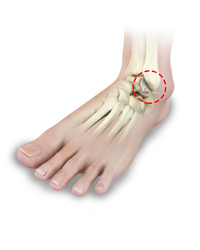
Bunions
Bunion is latin for turnip. It is also the bump at the base of your big toe. The medical name for this condition is Hallux Valgus. It only requires treatment if it is painful or interfering with shoes, and the first line treatment is conservative, with wide, deep toe-box footwear, silicone pads, sleeves or insoles. Surgery is required only if pain and/or difficulty wearing shoes persists despite conservative measures.
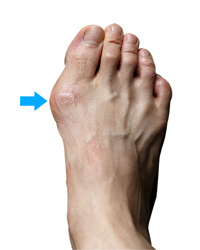
Claw Toe
Claw toe is a deformity, where a toe bends and appears like a bird’s claw. The affected toe is bent upward from the joint at the ball of foot, and downward at the joints in the middle and tip of the toe to curl under the foot. Hard thick skin called corns may develop under the ball of the foot or on the top of the affected toe, causing pain while walking.
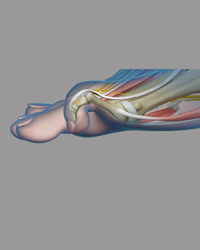
Hammer Toe
This is a deformity of the lesser toes (2nd, 3rd or 4th) of the foot. The toe is bent at the middle joint. It can result in pain on top of the toe knuckle (proximal interphalangeal joint) and also the tip of the toe. It can be the cause of corns.
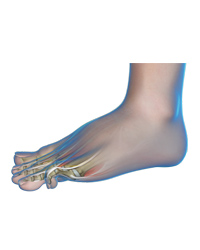
Heel Pain
The heel is made up of the calcaneus bone and supported by a network of muscles, tendons, ligaments and soft tissues, which together support the weight of the body and stress during movement. Heel pain is a common symptom of excessive strain placed on these structures.
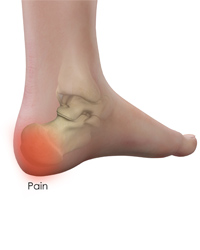
Ingrown Toenail
An ingrown toenail is a common and painful condition of the toe. It occurs when the sides or corner of the nail grow inwards and penetrates the skin of the toe. Pain is often accompanied by swelling and redness. The big toe is affected most often.
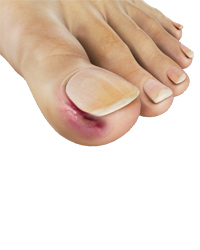
Toe Deformities
Anatomically the foot is divided into the forefoot, mid foot and hind foot. The Forefoot has 4 small toes called phalanges and 1 large toe called the hallux or big toe. Phalanges have 3 bones and 3 joints, while the big toe has 2 bones and 2 joints. The mid foot and hind foot have different structures, which are responsible for bearing body weight and performing activities such as walking and running.
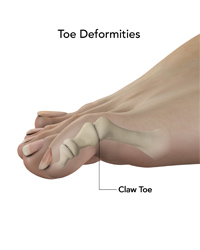
Morton's Neuroma
A common cause of forefoot pain is a thickened, irritated nerve called a Morton's neuroma. It is characteristically associated with pain in the ball of the foot and shooting pains into the toes and often burning or tingling in the affected toes.
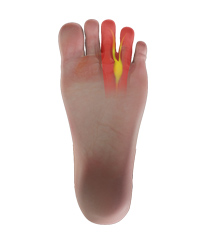
Plantar Fasciitis
One of the most common causes of heel pain is a problem called "plantar fasciitis". Plantar fasciitis is the term doctors use when a part of the foot called the plantar fascia gets irritated or inflamed. The plantar fascia is a tough band of tissue that connects the heel bone to the toes.
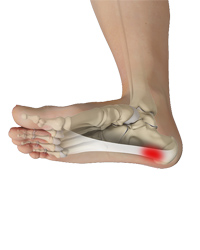
Posterior Tibial Tendon Dysfunction
The posterior tibial tendon passes through the ankle to attach the calf muscle with the bones of the mid foot. It provides stability to the arch and supports the foot while walking. Inflammation or a tear of this tendon as a result of injury may cause dysfunction, leading to pain and the development of flatfoot.
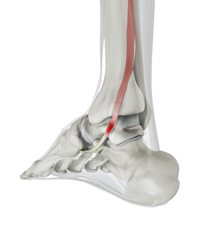
Rheumatoid Arthritis of the Foot & Ankle
Ankle arthritis is a degenerative condition which is usually a result of previous trauma to the ankle joint. It can also be the result of auto-immune or inflammatory conditions. It results in pain, swelling and restriction in range of motion and often a deformity.

Stiff Big Toe (Hallux Rigidus)
This is a degenerative condition affecting the big toe (hallux) metatarsophalangeal (MTP) joint at the base of the toe. It results in pain and restriction of movement (rigidus). The changes in the joint are essentially those of osteoarthritis, with loss of cartilage, formation of osteophytes at the joint margin (spurs) and changes in the bone (hardening or sclerosis).
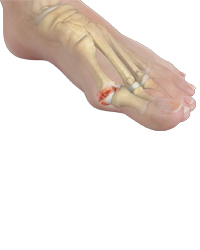
Tarsal Tunnel Syndrome
Tarsal tunnel is the gap that is formed between the underlying bones of the foot and the overlying tough fibrous tissue. Tarsal tunnel syndrome refers to a condition where the posterior tibial nerve that lies within the tarsal tunnel is compressed. The condition occurs when the tibial nerve is pinched.
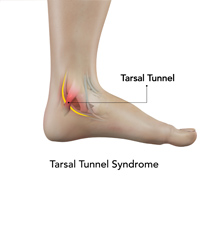

Ankle Instability
Ankle instability is a chronic condition characterized by a recurrent slipping of the outer side of the ankle. It usually results from repeated ankle sprains. It is generally noticed during movement of the ankle joint but can also occur during standing as well.
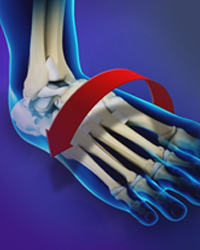
Cavus Foot Deformity
A cavus foot or a high-arched foot refers to a condition that can vary from a slightly high arch to a severe deformity. Cavus foot can lead to symptoms such as pain and instability. The condition may be inherited or associated with neurological disorders or other conditions.










